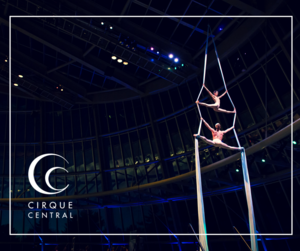Aerial How To and FAQ: Rigging Aerial Apparatus at Your Venue Part
You’ve heard the buzz, seen it on social media or experienced the awe of a "trapeze artist" (a.k.a. an Aerialist) in person and now you're obsessed! You are set on elevating your next event with these gravity defying talented acrobats.
The next question then becomes...How?
There ARE event venues that regularly accommodate aerialists which have production teams built into their event infrastructure streamlining aerial performance of any kind! Unfortunately, these venues are few and far between. If you aren't lucky enough to find yourself in that kind of best case scenario - have no fear! We've got all the info you need...
FAQ's - A few typical questions/concerns regarding aerial logistics at venues are:
Are the ceilings high enough?
Where can you hang from? / What do you dangle off of?
What if my event is outdoors?
3 Things You Need to Know About Rigging Aerial at Your Event Venue
"I'm not sure if the ceilings are tall enough"
1. Ceiling Height - the biggest misconception about aerial performance requirements is that the venue needs to have high ceilings - this is actually not completely true.
An experienced aerialist, especially in NYC where space is a premium, can work with just about any height (if you really need a minimum number - it's about 12' for vertical apparatuses such as silks and the rest can get by with a 9 or 10 ft. minimum).
A higher ceiling does allow aerialist to perform different kinds of tricks and skills, making the added fly room a luxury, but not a requirement! *note the word is different not better.
Don't forget that space is also necessary below the aerialist! A 6' minimum circumference of ground space below the artist will help avoid silk tails in wine glasses and the unintended kicks. It is also helpful to have a person supervising on the ground or stanchions help to guide guests away from the "danger zone" during events.
"Where can you hang from? / What do you dangle off of?"
2. Rigging Capability - The most important determining factor of whether or not aerial is possible at a venue is the ability to rig aerial apparatus.
"Rigging," in the most basic terms, is the way that aerialists and their riggers securely attach apparatus (silks, hoop, trapeze, etc.) to a structure in order to suspend from it.
An aerial rigging point is created by attaching rigging equipment to a venue’s structure. This is performed by experienced aerialists and aerial riggers. The aerial apparatus of choice is then attached to the rigging point. This is most easily done when the venue has:
Accessible (or ideally, exposed) structural beams. (not accent beams or exposed pipes -- you would be surprised and terrified at some of the things people think they can rig off of!)
The ability to safely access the beams using a lift or A-frame ladder.
*Note - if your venue already has rigging points it is imperative that they are inspected by the aerialist/rigger to assess whether or not they are up to safety standards.
"We can't get to the Beams / My event is outdoors"
3. Free Standing Aerial Rigging - Oftentimes, rigging to the venue's structure is just not possible...what then?
Maybe there is no way to access structural beams because they are embedded in a finished ceiling.
Sometimes a venue has exposed structural beams, but they are not in an ideal location based on the event floor plan or maybe the venue doesn't have a lift or A-frame ladder that can safely reach them.
OR - What if the event is outdoors?
This is where Freestanding Aerial Rigging comes in! There are various sizes, logistics and options which we will be covering in our next blog: Rigging Aerial Apparatus at Your Venue Part II
If you think our content is informative or just pretty to look at, share it on the Facebook, Instagrams or wherever else you're Pinterested in these days!

